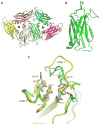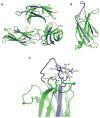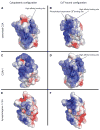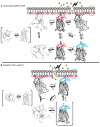Alternate splicing of dysferlin C2A confers Ca²⁺-dependent and Ca²⁺-independent binding for membrane repair
- PMID: 24239457
- PMCID: PMC5993433
- DOI: 10.1016/j.str.2013.10.001
Alternate splicing of dysferlin C2A confers Ca²⁺-dependent and Ca²⁺-independent binding for membrane repair
Abstract
Dysferlin plays a critical role in the Ca²⁺-dependent repair of microlesions that occur in the muscle sarcolemma. Of the seven C2 domains in dysferlin, only C2A is reported to bind both Ca²⁺ and phospholipid, thus acting as a key sensor in membrane repair. Dysferlin C2A exists as two isoforms, the "canonical" C2A and C2A variant 1 (C2Av1). Interestingly, these isoforms have markedly different responses to Ca²⁺ and phospholipid. Structural and thermodynamic analyses are consistent with the canonical C2A domain as a Ca²⁺-dependent, phospholipid-binding domain, whereas C2Av1 would likely be Ca²⁺-independent under physiological conditions. Additionally, both isoforms display remarkably low free energies of stability, indicative of a highly flexible structure. The inverted ligand preference and flexibility for both C2A isoforms suggest the capability for both constitutive and Ca²⁺-regulated effector interactions, an activity that would be essential in its role as a mediator of membrane repair.
Copyright © 2014 Elsevier Ltd. All rights reserved.
Figures








Similar articles
-
Structural Basis for the Distinct Membrane Binding Activity of the Homologous C2A Domains of Myoferlin and Dysferlin.J Mol Biol. 2019 May 17;431(11):2112-2126. doi: 10.1016/j.jmb.2019.04.006. Epub 2019 Apr 18. J Mol Biol. 2019. PMID: 31004665 Free PMC article.
-
Quantitation of the calcium and membrane binding properties of the C2 domains of dysferlin.Biophys J. 2014 Jan 21;106(2):382-9. doi: 10.1016/j.bpj.2013.11.4492. Biophys J. 2014. PMID: 24461013 Free PMC article.
-
Calcium-sensitive phospholipid binding properties of normal and mutant ferlin C2 domains.J Biol Chem. 2002 Jun 21;277(25):22883-8. doi: 10.1074/jbc.M201858200. Epub 2002 Apr 16. J Biol Chem. 2002. PMID: 11959863
-
On the role of dysferlin in striated muscle: membrane repair, t-tubules and Ca2+ handling.J Physiol. 2024 May;602(9):1893-1910. doi: 10.1113/JP285103. Epub 2024 Apr 14. J Physiol. 2024. PMID: 38615232 Review.
-
Dysferlin function in skeletal muscle: Possible pathological mechanisms and therapeutical targets in dysferlinopathies.Exp Neurol. 2016 Sep;283(Pt A):246-54. doi: 10.1016/j.expneurol.2016.06.026. Epub 2016 Jun 25. Exp Neurol. 2016. PMID: 27349407 Review.
Cited by
-
Analysis of Dysferlin Direct Interactions with Putative Repair Proteins Links Apoptotic Signaling to Ca2+ Elevation via PDCD6 and FKBP8.Int J Mol Sci. 2023 Feb 28;24(5):4707. doi: 10.3390/ijms24054707. Int J Mol Sci. 2023. PMID: 36902136 Free PMC article.
-
Functions of Vertebrate Ferlins.Cells. 2020 Feb 25;9(3):534. doi: 10.3390/cells9030534. Cells. 2020. PMID: 32106631 Free PMC article. Review.
-
Anoctamins/TMEM16 Proteins: Chloride Channels Flirting with Lipids and Extracellular Vesicles.Annu Rev Physiol. 2017 Feb 10;79:119-143. doi: 10.1146/annurev-physiol-022516-034031. Epub 2016 Nov 16. Annu Rev Physiol. 2017. PMID: 27860832 Free PMC article. Review.
-
Screening two mutations in the dysferlin gene by exon capture and sequence analysis: A case report.Exp Ther Med. 2016 Jul;12(1):41-44. doi: 10.3892/etm.2016.3332. Epub 2016 May 11. Exp Ther Med. 2016. PMID: 27347015 Free PMC article.
-
Structural Basis for the Distinct Membrane Binding Activity of the Homologous C2A Domains of Myoferlin and Dysferlin.J Mol Biol. 2019 May 17;431(11):2112-2126. doi: 10.1016/j.jmb.2019.04.006. Epub 2019 Apr 18. J Mol Biol. 2019. PMID: 31004665 Free PMC article.
References
-
- Ampong BN, Imamura M, Matsumiya T, Yoshida M, Takeda S. Intracellular localization of dysferlin and its association with the dihydropyridine receptor. Acta Myol. 2005;24:134–144. - PubMed
-
- Bansal D, Miyake K, Vogel SS, Groh S, Chen CC, Williamson R, McNeil PL, Campbell KP. Defective membrane repair in dysferlin-deficient muscular dystrophy. Nature. 2003;423:168–172. - PubMed
Publication types
MeSH terms
Substances
Grants and funding
LinkOut - more resources
Full Text Sources
Other Literature Sources
Molecular Biology Databases
Miscellaneous

